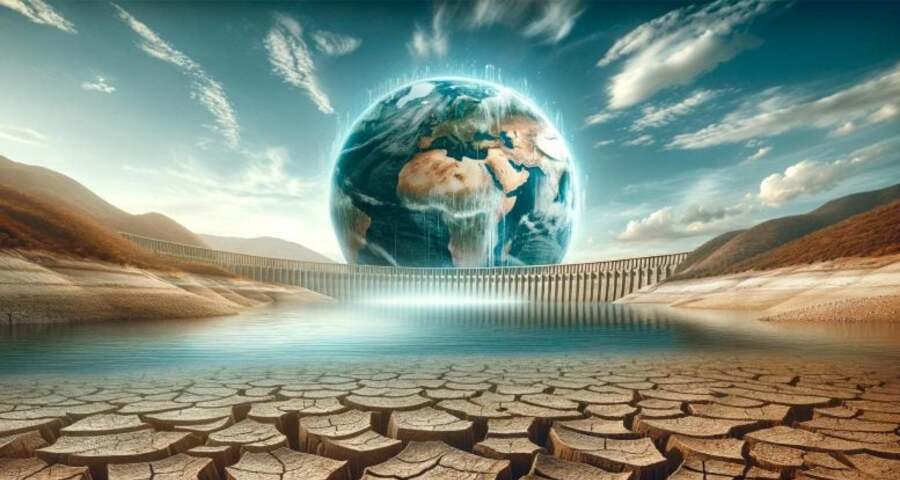Our world is changing in a way that we cannot ignore, under the influence of solar heat, which becomes stronger every year. The United Nations recently warned that the stability of the Earth’s water cycle is under threat due to climate change.
A dry planet
In 2023, water resources became extremely scarce, reaching a thirty-year drought record. At the same time, glaciers deposited huge amounts of ice on the continent, recording the greatest loss in half a century. While at one end of the spectrum there was extreme drought, at the other end there was a significant water surplus with floods across the country.
Celeste Saulo, head of the World Meteorological Organization (WMO), expressed concern about these stark warning signs.
“Water is the canary in the coal mine of climate change,” Saulo said. The growing panic underscores that human lives, ecosystems and economies are on the brink of climate-induced disaster.
Water balance against climate change
The heated state of the Earth, the result of a rapidly warming atmosphere, makes our water cycle turbulent and difficult to predict. Last year had the dubious distinction of being the hottest year on record; Therefore, many parts of the world experienced long-term drought.
At the same time, other parts of the world struggled with rivers overflowing, leading to severe flooding. These weather events were caused in part by natural climate changes such as La Niña and El Niño, but human-caused climate change has made them worse.
“A warmer atmosphere holds more moisture, which contributes to heavy rainfall. Faster evaporation and drying of soils make drought conditions worse,” Saulo said.
Water problems due to climate change
The ironic balance between water excess and scarcity is driving many countries into increasing water crises. In 2023, Africa bore the brunt of these disasters, with a staggering number of human casualties.
Severe flooding in Libya in September led to the catastrophic collapse of two dams, killing more than 11,000 people and killing 22% of the country’s population. On the other hand, more than half of the world’s river basins have been drier than normal in the last three years.
According to the United Nations, approximately 3.6 billion people do not have access to fresh water for at least one month of the year. Alarmingly, this number is predicted to rise to over 5 billion by 2050.
terrible size
As our planet continues to warm, our glaciers are paying a heavy price. It is melting at an unprecedented rate, with 600 billion tonnes of water lost in the worst performance in 50 years, according to data from September 2022 to August 2023.
The WMO chief warns that these losses threaten the long-term water security of countless communities around the world. With all this in mind, Saulo calls for decisive action to find a solution to this looming crisis.
Difference in water availability
The gap between water-rich and water-poor regions is widening with awareness of climate change, and innovative solutions are needed to close this critical gap. Technological advances such as desalination and rainwater harvesting offer promising ways to redistribute water efficiently.
Desalination, although energy-intensive, could potentially convert seawater into drinkable water and provide relief in arid regions. Rainwater harvesting systems adapted to the local climate can reduce the effects of lack of rainfall by storing excess water during rains.
In addition, international cooperation is extremely important as countries need to share resources and knowledge to holistically adapt to the challenges of water scarcity. Fundamentally, addressing inequalities in water availability requires a concerted global effort that emphasizes sustainable practices and equitable distribution.
Quick action required
World leaders face pressure to turn their rhetoric about the water crisis into actionable strategies. Key actions include investing in climate resilience, integrating traditional knowledge with modern science, and prioritizing education to promote water conservation. Rapid action is needed to alleviate the looming water scarcity crisis and ensure a sustainable future for future generations.
Observation of the Earth’s water cycle
For the effective management of freshwater resources, WMO strongly advocates improved monitoring systems. They will act as early warning systems, mitigating disaster for both people and the ecosystem.
Better water management can only be achieved if we understand our use and changes in availability. “We cannot manage what we cannot measure,” Saulo emphasized.
Stephan Uhlenbroek, Director of the WMO Department of Hydrology, Water and Cryosphere, emphasized the need to invest in infrastructure to protect water and protect people from water-related disasters. Changes are especially needed in agriculture, which consumes 70% of the world’s fresh water.
As the world moves towards a future where normal water cycles may become a distant memory, the challenge of stabilizing the climate seems daunting. While we cannot turn back the clock, we can certainly strive to understand, adapt and combat these changes to give our future generations more time.
Source: Port Altele
